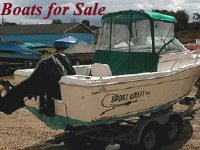|
Hot Early Summer Walleyes
by Ron Anlauf
There's probably no
better time to be on the water than right now,
 especially
if you're a walleye angler. The action can be some of the best and it
can also be the worst, depending on how you react to the season’s
changing conditions. To be successful, anglers will have to give up on
what had been productive just a few short weeks ago and get with a
program more in tune with a walleye’s present needs. especially
if you're a walleye angler. The action can be some of the best and it
can also be the worst, depending on how you react to the season’s
changing conditions. To be successful, anglers will have to give up on
what had been productive just a few short weeks ago and get with a
program more in tune with a walleye’s present needs.
When the summer sun
starts bearing down water temps can make a quick jump and is when early
season patterns can completely dry up. When it happens many anglers
make the mistake of believing that the walleyes are simply not feeding,
but nothing could be further from the truth. In fact walleyes will feed
heavily at this time of the year, you just need to have a good handle on
where they're doing it.
One of the reasons
anglers can find the going during the summer months a little tough is
because make they haven’t made the necessary adjustments required to
stay with a fish that’s on the move. Walleyes make a living by taking
advantage of their opportunities and in many cases those opportunities
are no where near where they where at the beginning of the season.
As spring slides into
summer there is a shallow to deep migration that occurs on most bodies
of water. The migration doesn’t happen overnight, and not all of the
walleyes in a system make the move to deep structure. Instead, the
process more likely begins with a few scattered groups of fish showing
up on deeper haunts followed by a slow and steady migration that
eventually results in fishable numbers of walleyes. Exceptions to the
"migration rule" include bodies of water that start out clear and
darken up due to excessive fertility and heavy algae blooms. In that
case you might find walleyes starting out shallow, moving deeper, and
then creeping back up as visibility is reduced.
One of the most
appealing aspects of locating walleyes holding on deeper structure is
the fact that they show up readily on good electronics. With a high
quality graph like the Humminbird 987C you can quickly narrow down your
search. The 987C's high level of definition can help you locate
walleyes that are holding belly bottom, which is a common occurrence.
It also has a unique capability of being able to look out to the side
instead of straight down, and you can cover a wide swath and either find
fish or eliminate water. By cruising back and forth over likely areas
you'll get a good idea from your electronics whether or not the time is
right to actually start fishing.
The key to the whole
process is keeping your lines boat, and relying totally on your
electronics to divulge the whereabouts of deep running walleyes. It
takes a little self control, but you can save a ton of valuable time if
you do the investigative work up front. The fact is you’ll never ever
catch them where they’re not and if you’re not marking; you’re not on ‘em..
GPS is another
terrific time saving device especially when you combine it with a chart
plotter and a high definition electronic map like those available from
Navionics. With a unit like the 987C combined with a Navionics chip you
can see potential walleye hideouts and where you are in relationship to
it all. As you cruise potential hangouts you can place icons on the
screen where you've marked schools of fish, allowing you to return to
the exact spot after your investigative work is done.
Once you’ve marked
enough fish in a particular area it’s time to get down to business and
try to put a couple in the boat. Good summer presentations typically
involve an element of speed, like trolling crankbaits or spinners. With
an increase in water temperature a walleye’s metabolism increases
accordingly. A quicker moving bait appeals to that bump in metabolism
and will often get snapped up while a slower offering might be
completely ignored.
A top pick for working
unfamiliar waters would have to be trolling a rig like a Northland
Tackle Rainbow Spinner tipped with a big crawler behind a heavier
bouncer like a two ounce Rock Runner. Bottom bouncers run
relatively snag-free which can be a big plus when working an uneven
bottom with plenty of potential hang-ups. They also allow you to keep
your bait running close to the bottom without actually dragging it, and
helps to keep your offering at ‘eye level.
While walleyes can be
caught consistently all summer long, the hottest action typically occurs
at the front end. The best of the best is probably happening right now
and if you wait too long you could miss out on a seasonal peak, and
that's the last thing you want to do. See you on the water. |






 especially
if you're a walleye angler. The action can be some of the best and it
can also be the worst, depending on how you react to the season’s
changing conditions. To be successful, anglers will have to give up on
what had been productive just a few short weeks ago and get with a
program more in tune with a walleye’s present needs.
especially
if you're a walleye angler. The action can be some of the best and it
can also be the worst, depending on how you react to the season’s
changing conditions. To be successful, anglers will have to give up on
what had been productive just a few short weeks ago and get with a
program more in tune with a walleye’s present needs.